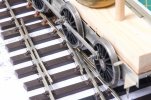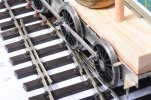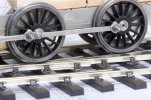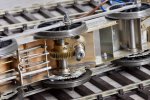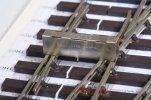RichardG
Western Thunderer
Trial runs on a three-rail garden railway

The second trial away from home has also gone pretty well. Coarse scale plain track is straightforward except where small twigs cause derailments. It seems a dead track system will run well as long as debris e.g. leaves is small enough for the loco to run over or push out of the way.
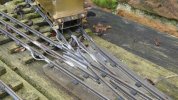
Performance on coarse scale pointwork varies. The loco and tender can negotiate both legs of this point in both directions thanks to relatively tight flangeways beside the checkrails.
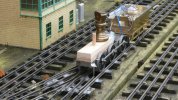
Conversely the loco and tender can manage only the straight leg here. The larger gaps beside check rails and wing rails lead to derailments at every attempt on the curved leg.
Realistically, this means the completed loco should be able to do complete circuits of this railway come the Spring because it will encounter only the straight legs of points on the main line.

The second trial away from home has also gone pretty well. Coarse scale plain track is straightforward except where small twigs cause derailments. It seems a dead track system will run well as long as debris e.g. leaves is small enough for the loco to run over or push out of the way.

Performance on coarse scale pointwork varies. The loco and tender can negotiate both legs of this point in both directions thanks to relatively tight flangeways beside the checkrails.

Conversely the loco and tender can manage only the straight leg here. The larger gaps beside check rails and wing rails lead to derailments at every attempt on the curved leg.
Realistically, this means the completed loco should be able to do complete circuits of this railway come the Spring because it will encounter only the straight legs of points on the main line.


